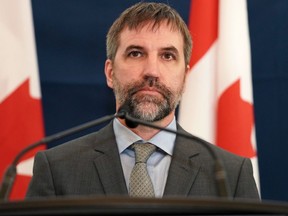
[ad_1]
It’s no surprise the Alberta government and the country’s oil and gas industry fiercely oppose the Trudeau government’s incoming cap on greenhouse gas emissions from the sector, highlighted by new submissions to Ottawa this week.
But if you dive into the province’s report filed with the federal government, it includes some new economic analysis that helps explain why they’re so concerned.
A forecast by the Conference Board of Canada on the potential fallout of the federal policy — contained in Alberta’s 24-page submission — underscores what it calls the “severe negative impacts,” including:
- 82,000 to 151,000 jobs lost by the end of the decade across the country, including between 54,000 and 91,000 in Alberta;
- Nominal gross domestic product (GDP) in Canada reduced cumulatively between $600 billion and $1 trillion from 2030 to 2040. Alberta’s GDP would decline by 3.8 per cent in that period;
- Alberta government revenues chopped by $73 billion to $127 billion in the next decade, while federal revenues tumble between $84 billion and $151 billion.
“They are big numbers. And we were trying to make the case to Ottawa that when Alberta does well, Canada does well,” Premier Danielle Smith said Wednesday in an interview.
“I’m hoping that self-interest kicks in here at some point . . . There’s no reason for them to try to kneecap our industry. It just hurts everyone.”
The analysis adds more ammunition to an acrimonious debate between the federal and provincial governments over the policy, which is part of Canada’s broader climate plan to reach net-zero emissions by 2050.
The Conference Board study was commissioned by the province, with work conducted by the think-tank over the past two months.
That’s part of what makes it so interesting, as it’s based on the new framework for the oilpatch emissions cap released by the Trudeau government in December.
“The policy, as it’s announced right now, in our view is going to lead to significantly slower growth of the oil and gas sector, across the country and materially in Alberta,” said the board’s director of economic research, Tony Bonen.
“And it comes at a fairly high cost, in terms of the price-per-megatonne of greenhouse gas emissions that are reduced.”
-
 ’Not be tolerated’: Alberta files formal response to proposed oilsands emissions cap
’Not be tolerated’: Alberta files formal response to proposed oilsands emissions cap -
 Alberta gearing up for another court battle over Ottawa’s oil, gas emissions cap
Alberta gearing up for another court battle over Ottawa’s oil, gas emissions cap -
 Varcoe: ‘Unworkable, untenable’ — Alberta business leaders want Ottawa to scrap Canada’s oil and gas emissions cap
Varcoe: ‘Unworkable, untenable’ — Alberta business leaders want Ottawa to scrap Canada’s oil and gas emissions cap -
 ‘An intentional attack’: Alberta reacts to new federal oil and gas emissions cap
‘An intentional attack’: Alberta reacts to new federal oil and gas emissions cap -
 Would Alberta win a court battle over the emissions cap? What is a cap-and-trade system? Here’s what you need to know
Would Alberta win a court battle over the emissions cap? What is a cap-and-trade system? Here’s what you need to know
The report looked at the consequences for oil and gas production if the planned federal emissions targets for the sector are not achieved by 2030 — particularly government assumptions surrounding technological and efficiency gains — leading to assumed output cuts.
While the industry can take lower-cost steps to lower its methane emissions, there would still be a gap to meet Ottawa’s goal for the oilpatch.
That would lead to reduced production growth — down about 11 per cent from the Conference Board’s base case — as oil and gas “gets left in the ground,” next decade, Bonen said.
“Some higher cost, less economically efficient, projects will not move forward in our scenario. And some that are operating now, but at a higher cost, are probably stopped. But there will still be net new wells drilled and new production produced.”
(The data is based on the board’s most likely scenario, as two other ones it examined showed a greater effect on jobs and GDP.)
Bonen estimated the costs of lowering emissions through production cuts at about $1,600 to $1,700 for every megatonne reduced through the cap.
Under its forecast, the cap would lead to a permanent one-time cut in Canadian GDP of 0.9 per cent between 2030 and 2040.
“We are going to require substantial changes to our economic systems to address the climate crisis,” Bonen added.
“For us, it’s very important to be clear on where those impacts are going to be felt and be honest about the size of those impacts — so we can start adjusting and planning ahead for them.”
The provincial submission also called on the federal government to release its assessment of the economic effects of the cap from 2030 forward.
That is coming “and will be available when the government publishes draft (cap) regulations later this year,” a spokesperson for federal Environment Minister Steven Guilbeault said in an email.
“The fact is, a cap on oil and gas emissions is smart economic policy — it will help ensure the sector’s long-term competitiveness in a rapidly decarbonizing world.”
The oil and gas industry is the largest emitting sector in Canada. The Liberal government has introduced a series of policies — including a national price on carbon, clean fuel regulations and the incoming emissions cap — as concerns around climate change mount.
The federal cap seeks to lower industry emissions by 35 to 38 per cent by the end of the decade from 2019 levels. Some flexibility measures, such as letting companies buy offset credits or contribute to a decarbonization fund, could shrink it to 20 per cent.
The cap is expected to be phased in between 2026 and 2030.
Canada is the world’s fourth-largest oil producer and the sector directly employed 178,000 people across the country in December.

The provincial submission says the cap will also affect the Canadian construction, manufacturing and service sectors, as well as the financial, restaurant and hospitality industries.
University of Calgary economist Trevor Tombe said there are too many unanswered questions about the cap to fully understand the economic consequences of the policy.
But he said it’s clear the effect will be significant, hitting one region of the country much harder than the rest.
“Whether it’s $600 billion to $1 trillion, as the Conference Board puts it out, or some other set of numbers, it’s going to be big — that is the takeaway from these numbers,” Tombe said.
Industry groups are united in their opposition to the cap, calling for it to be scrapped.
The Pathways Alliance group, which represents large oilsands operators, maintains the cap is unnecessary and unworkable, saying it will deter investors from the sector and it risks curtailing production.
The group is working to reach net-zero emissions by 2050 and is developing a $16.5-billion carbon capture and storage network in Alberta.
“I would say (the cap) is singularly unhelpful in advancing decarbonization investment of any kind, including the Pathways project. Unfortunately, all it does is send a message to investors that Canada is not open for business,” Pathways Alliance president Kendall Dilling said in an interview.
“At this point, in good faith, we will keep our heads down, keep investing, keep working and trust that sanity will prevail.”
In its submission, the Canadian Association of Petroleum Producers (CAPP) noted emissions from the conventional oil and gas sector fell by 24 per cent, while production grew by 21 per cent between 2012 and 2021.
“We are hoping that this framework is put on ice, so that we can really look at this thoughtfully and realistically,” said CAPP president Lisa Baiton.
Chris Varcoe is a Calgary Herald columnist.
[ad_2]
You can read more of the news on source





